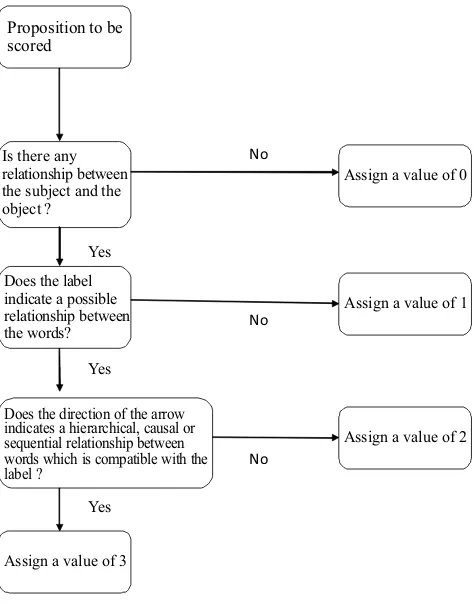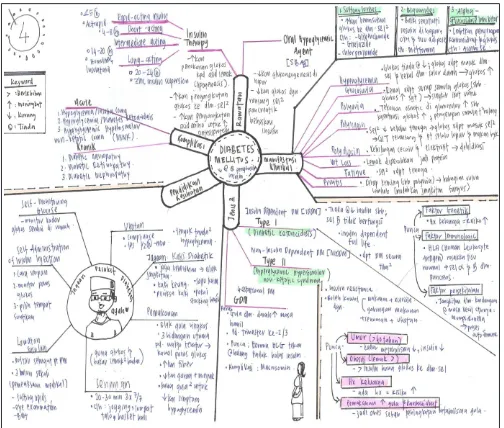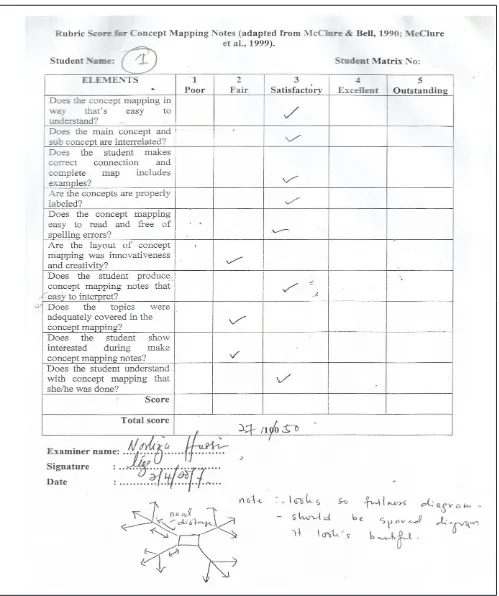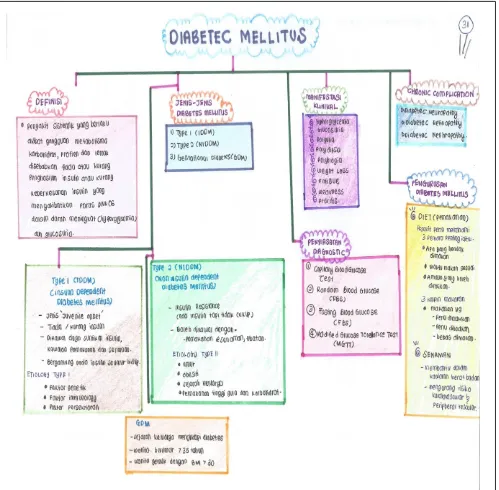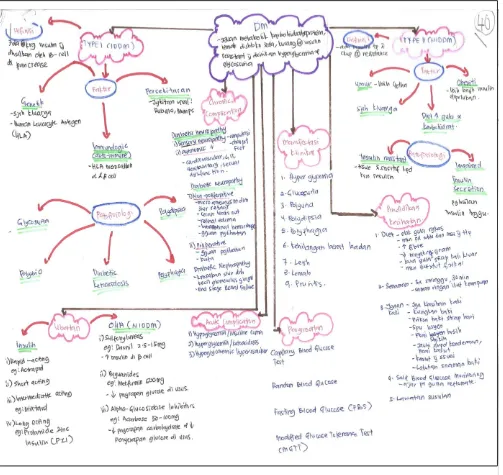ABSTRACT
Introduction: The teacher centered approach is a teaching and learning strategy has been practiced traditionally for long in the classroom. Through this strategy the teacher plays an important role, while the students only act as spectators, the interaction between students and teachers is only one way. In this study, the concept mapping notes was added in teaching and learning methods during classroom teaching. Concept mapping is one method of teaching that encourages students to becomes independent learner, critical thinking and competent in their work.
Methodology: This study was carried out in Kolej Kejururawatan Kubang Kerian (Kelantan), and Kolej Kejururawatan Pulau Pinang. The respondents were selected using simple random sampling. There were 109 respondents. The respondents were given 40 minutes to develop the concept mapping notes.
Results: The activity of the students in the teaching is certainly a positive sign towards achieving their learning. The example of variety concept maps construct done by the students are highly creative and innovative.
Conclusion: Students should take responsibility for their own learning. However, that is a role of a educator to choose the best teaching method to makes the learning become meaningful and effective toward the student cognitive structure that will help them to understand the topic those were taught.
Keywords: Concept mapping notes, Classroom teaching, Nursing students.
1* 2 2
Rusnani binti Ab Latif , Akehsan Hj. Dahlan , Zamzaliza binti Ab Mulud ,
3
Hj. Mohd Zarawi Mat Nor
Malaysian Journal of Medical Research | Vol. 2 (1) JANUARY 2018 |
*Corresponding Author Email:
rusnani.adnan@yahoo.com
37
INTRODUCTION
Teacher centered approach is a teaching and learning strategy that has been practiced traditionally for a long time in the classroom. Through this strategy the teacher plays an important role, while the students only act as spectators and the interaction between students and teachers is only one way. The teacher centered approach does not allow nursing students the time to develop clinical judgment skills, problem solving abilities or nursing care skills (Li-Ling, 2006). In teacher centered learning, a lot of lectures are delivered by teachers, while students only act as a listener and recipient. Teachers only use techniques such as demonstrations, storytelling, explaining and lecturing. Teacher centered strategies students do not have the opportunity to give their views and opinions as their only opportunity to hear anything presented by the teacher, and then
memorize important facts related to the exam.
These learning conditions limit students to make their own interpretations related to the lesson. Rote memorization has been an accepted learning method in the past, but it no longer recommended because there is no deep meaning integrated into this type of learning (Kumar, Dee, Kumar, & Velan, 2011). In this study, the concept mapping notes was added in teaching and learning methods during classroom teaching. Concept mapping notes are done by the students during section of teaching and learning of Diabetes Mellitus subject using concept mapping. Concept mapping is one method of teaching that encourage students to becomes independent learner, critical thinking and competent in their work. Concept mapping notes help the students to easily understand the subject interest more thereby understanding nursing in depth.
IN CLASSROOM TEACHING.
1
Kubang Kerian Nursing College, Kubang Kerian, Kelantan, Malaysia
2
UiTM, Puncak Alam, Bandar Puncak Alam, Selangor, Malaysia
3
LITERATURE REVIEW
The advantages and benefits of concept mapping notes
i . Alternative method to evaluate student's academic performance.
Concept mapping notes also can becomes alternative method to evaluate academic performance. It can be replace the traditional test that usually uses multiple choice question (MCQ) or short essay question (SEQ). Concept mapping can be used to assess the higher order learning objectives which cannot be measure by objective type questions (Novak & Gowin, 1984). Concept mapping is a better alternative to assess both qualitative and quantitative aspect of learning because of it’s flexibility and adaptability (Andrews, Tressler & Mintzes, 2008).
Nurse educators can use concept mapping notes as a formative assessment during the teaching learning process in the classroom to improve their teaching and to make learning meaningful. It is because concept mapping notes was evaluated using rubric score after the topic of subject have been taught. The learning strategy would help the students to shift the learning pattern from rote learning to meaningful learning, because it needs the student to involved in the learning process actively whether in individual or group work. For constructing a concept map nursing students requiresto examine the relationships among concepts, and need to linkthe concept to previous knowledge (Pilcher, 2011).
ii. Improves students learning
Concept mapping is most effective when accompanied with comprehensive training, instructor guidance and long-term practice (Pickens, 2007). Successful use of concept mapping requires practice and a willingness of people to be open to a great deal of trial and error and ambiguity. Although development of concept mapping requires lot of time for the first time, but once the learners is familiar and have gained mastery in developing a concept map, the learner will believe that it improves the their learning.
iii. Allowed students to see in deep health problems of patients
Student generated concept maps provided in-depth examples of how nursing students think. Each map
provided snapshot of students' conception of the units of study. Concept mapping notes of patient problems allowed students to see interrelationships in patient data, analyze the patient data and plan comprehensive nursing care. At the same time, concept mapping notes session had provided students with a medium and opportunity to discuss differences in their thinking about the unit of study. Those discussions, in turn encourage meaningful debate if done in groups.
According to Novak and Govin (1984), “in order to construct a hierarchical concept map, one must think through what one perceives to be the most inclusive, less inclusive and least inclusive concepts in any body of subject matter. Concept maps, used as tools for negotiating meaning, can make possible new integrative reconciliations that in turn lead to new and more powerful understanding”.
iv. Build good relationships between lecturer and students
In the same time, concept mapping allows the lecturer to interact with the students in real time during construction of the concept mapping notes. The lecturers can give quick feedback regarding the students understanding on the topic that they have taught, based on concept mapping notes that is developed by the students. This indirectly, enhances students' performance.
v. Increase creativity of students in learning
From the concept mapping notes, the researcher can see that different students produced different view and ideas about the same topic on “Diabetic Mellitus” based on their understanding. Concept mapping notes also showed the creativity of the students in brainstorming their ideas in exploration of knowledge. It gives opportunity to students to express their ideas without any interruption and reduces their anxiety about that subject (Jegede, Alaiyemola & Okebukola,1990)
vi. Identify the understanding of the students based on missing or inadequate information
gives the chance to the nurse educators to take alternative action such as call the weak students and give them teaching in individual or make focus group discussion.
According to Novak and Gowin (1984) “concept maps can make clear to the student (and the instructor for curriculum development purposes) how small the number of truly important concepts they have to learn.”
Concept maps are effective in identifying both valid and invalid ideas held by students. After student completed the development of their maps, nurse educators can examine how well a student understands regarding the topic they have learnt through their concept map. In this scoring the maps require human judgment, that researcher assign to nurse educators to evaluate the concept maps with comparison to a criterion or expert map.
vii. Help in determine the weakness students
The concept mapping notes also allows the nurse educator to know their students specific strengths and weaknesses, therefore educators can be focus toward the weaknesses of the students. For instance, the ability of the students to make connection between each and every concept. It also motivated the students to learn better and harder as this concept mapping notes were scored by rubric score. By using this scoring, it can be test and informed the educators about the success of their efforts of teaching the students. This can improve the teaching strategies in the classroom and then the students acquire a deep knowledge of the topic. As a result they can perform better in the clinical area. Concept mapping is an effective strategy to promote meaningful learning in different age groups and in a variety of fields (Novak & Gowin, 1984; Kinchin, 2011; Chang, Sung & Chen, 2001).
METHODOLOGY
This study was carried out in Kolej Kejururawatan Kubang Kerian (KKKK), Kelantan and Kolej Kejururawatan Pulau Pinang (KKPP). The respondents were selected using simple random sampling. There were 109 respondents. The students were given 40 minutes to develop the concept mapping notes. Students were taught the concept mapping process. They were asked to make concept mapping notes both individually and cooperatively related to the topic of Diabetes Mellitus. In two hour teaching, a total of 40
minutes of time was allocated for the respondent to complete it independently. The concept mapping notes were evaluated using a rubric score that were validated by four Expert panels using content and face validity.
The four evaluators were expert in the field of nursing education (vice principal, PSG College of Nursing, Coimbatore, Tamilnadu, India) and one expert in teaching pedagogy from Universiti Sains Malaysia, and two lecturers from Institute of Teacher Education (Institute Perguruan Guru (IPG) Kota Bharu and IPG, Kulim, Kedah). The experts were communicated through personal phone calls or emails to ask for their willingness. The full marks score was 50. This rubric score was adapted from scoring criteria based on the Relational Scoring System (RSS) or scoring system for a conceptual network (McClure & Bell,1990; McClure, Sonak & Suen, 1999) (see figure 1).
No Yes No Yes No Yes Is there any relationship between the subject and the object ?
Does the label indicate a possible relationship between the words?
Proposition to be scored
Does the direction of the arrow indicates a hierarchical, causal or sequential relationship between words which is compatible with the label ?
Assign a value of 1
Assign a value of 3
Assign a value of 0
Assign a value of 2
Figure 1: Relational Scoring System (RSS) or scoring system for a conceptual network (McClure & Bell, 1990; McClure et al., 1999)
After getting feedback from the four expert panel, researcher analyzed the content validity using the formula produced by Sidek Mohd Noah and Jamaludin
Ahmad (2005). The result is in percentage (%). This formula suggested that if the percentage of content validity achievement is more than 70% then good content validity and if less than 70% then the result is not good and is advisable to recheck the content according to the objective of study. The formula was followed as below:
X 100 = Content Validity Achievement Total Score From Expert (x)
Maximum Score (100)
Researcher selecting RSS as it has been modified and is based on the quality or importance of each component, with no regard to overall structure of the map (West et al., 2002). Evaluation criteria may also include content analysis or the number of items included in the map, the clarity of the organizational structure, and the way the content is categorized (Billings & Halstead, 2005). Rubric score was used to evaluate students work and help them understand how they will be evaluated (Thomas, 2011). It also useful to evaluate students' performance and level that they need to perform to get the PASS, CREDIT or DISTINCTION standard.
In this study, the concept mapping notes were evaluated based on the comparison with concept map that have been validate by experts. This rubric score was constructed using five point likert scale (1=poor; 2=fair; 3=satisfactory; 4=excellent and 5=outstanding). There were ten elements to guide the evaluator in assessing relevance and completeness and quality of concepts developed by the students. This rubric takes into account the following ten criteria: (1) concept easier to understand, (2) main concept and sub concept interrelated, (3) presence of correct connection and complete maps including example, (4) concept are properly labeled, (5) concept easy to read and free of spelling errors, (6) concept was innovative and creative, (7) the concept mapping notes produced by student were easy to interpret, (8) The topic are adequately covered, (9) students show interest during construction of concept mapping notes and (10) students understand the concept maps that she/he was done.
Data Collection
· Before studies were conducted, researcher provides information to teacher, assistant researcher how to
implement concept map in teaching. Researcher prepares lesson plans and teaching notes using concept maps to help teachers understand easily.
· During tutoring sessions, nurse educators were taught the topic for two hours using concept mapping methods and given a scenario based on case studies.
· The respondents were provided a two hour training class on the construction of concept maps.
· The respondents were taught how to construct a concept map during the orientation week of the semester.
· The respondents were asked to identify nursing diagnosis and nursing intervention and answer using concept mapping.
· After that the respondents tutoring sessions are asked to provide concept mapping notes as a response to their understanding of the topic in teaching. They were given 40 minutes to prepare it.
· The respondents were asked to prepare concept maps individually.
· These concept mapping notes was evaluated by two lecturers nursing from Universiti Sains Malaysia (USM). The selection of the examiners were based on characteristics such as experience in teaching Medical subject exceeding five years and have been taught the topic of Diabetes mellitus.
· This evaluation was based on the concept mapping notes guideline that has been prepared by the researcher and validated by expert panels.
STUDY ETHICS
Before carrying out this research project, an approval letter was being sent to Bahagian Pengurusan Latihan (BPL) and Directors of Nursing Colleges (Institusi Latihan Kementerian Kesihatan Malaysia (ILKKM) for consent. The researchers were explained regarding the aim and procedure of study to the respondents. The researcher also explained to the respondents that their answers were confidential and only used for the purpose of academic research. Written informed consent of all participants was being acquired.
RESULTS
The figures below show some examples of concept mapping notes that were constructed by students at different levels of achievement which demonstrates the knowledge structure of the student. The concept map below displays most of the components of a concept map structure. It is based on the topic of Diabetes Mellitus subject. The full mark is 50. Figure 1.1 shows
the concept mapping notes constructed by the students A and figure 1.2 shows the rubric score scoring for this concept mapping notes is 27/50. This concept maps showed fewer concepts and less connecting of concepts. The examiner gave comments that the concept maps was a big diagram, however the concept between each concepts should be separated.
Figure 1.1: Example of concept mapping notes developed by student (A)
The figure 2.1 displays the concept mapping notes constructed by the students B with the rubric score marks 30/50 (see in figure 2.2). The examiners gave commented
that the concepts maps looked good and were nicely constructed. The cross links between the concepts were easy to understand and the concept maps were distinct.
Figure 2.1: Example of concept mapping notes developed by student (B)
Meanwhile, figure 3.1 shows the concept mapping notes constructed by the students D. It shows high understanding and integrated knowledge structure, where the concept map shows good propositions and cross links with other concept and also reveals students' level of understanding. This concept maps got the highest score 36/50 that can seen in figure 3.2. These concept mapping notes were correctly enclosed and the words on
the linking lines, provided accurate relationships between and among the concepts. In addition these concept mapping notes were easy to understand and were interesting. The concept maps shows related concepts are linked in a meaningful way. These concept maps were easy to understand, innovative and creative. The innovation in this concept maps was enhanced by picture to illustrate the meaning of the concepts.
Figure 3.1: Example of concept mapping notes developed by student (C)
learning (Chei-Chang Chiou, 2008). Students have to become acquainted with the idea that they can construct their own knowledge and that the acquisition of new knowledge has to be firmly anchored to existing concepts (Ausubel, 1963).
CONCLUSION
Students should take responsibility for their own learning, however, it is the role of the educator to choose best teaching method to make the learning become meaningful and effective toward the student cognitive structure that will help them to understand about the topic that are taught. Therefore, student-centered learning is a teaching method that is effective and can change learning from passive to active. To achieve lifelong learning, however, the nursing curriculum should reflect the belief that students understand the concept, as opposed to rote memorization of facts.
In designing teaching learning methods the researcher must start with what educators want then the students will be able to master the subjects taught and teachers will receive evidence that the students have learnt. The activity of the students in the teaching is certainly a positive sign towards achieving their learning goals. Furthermore, the concept mapping notes developed by the student indicated the level of understanding of student regarding the subject. It helps the students to summarize and synthesize the subject that has been already taught. The process of making concept mapping notes helps the student to understand better in learning area on topic such as “Diabetes Mellitus”. By using rubric score based on the maps, the educators can evaluate the knowledge and understanding of the students to understand whether their teaching procedure was successful or not. The researcher also gave feedback based on their discussion with the teachers regarding the concept maps constructed by the students. Thus in this manner concept mapping notes are advantageous in classroom teaching.
DISCUSSION
The variety of concept maps constructed by the students were highly creative and innovative. In other word it can be said that excessive training for a long time period helped the students to improve and advance their construction of a good concept maps. The innovation in this concept mapping was enhanced with the addition of picture to illustrate the meaning of the concepts. In addition it makes the learner easy to remember the content. Walker (2003) stated that the graphic material and pictures painted to stimulate thinking, facilitate understanding and strength memory of the disciples and make the students more active in the classroom. The differences and the variety of concept mapping notes revealed the creativity and knowledge along with the understanding of the students.
In addition, the nurse educators can examine how well a student understands about the topic based on concept mapping notes. The teacher-made concept map was used as basis for grading the student work. When an expert creates a concept map, it is typically an elaborate, highly integrated framework of related concepts (Chi, Glaser & Far, 1988). This is a crucial issue to evaluate knowledge among students by mapping the assessment setting using scoring method (Klein et al., 2002).
Scoring scheme is a systemic method to evaluate students using concept mapping accurately and consistently (Ruiz-Primo, Schultz & Shavelson, 1997). Three main approaches are the following: (i) evaluation of components of a concept mapping; (ii) comparison with an expert concept mapping and (iii) combination of both. Usually, the scoring of concept mapping is accomplished by comparing a student's map with an expert's one, it is pointed out that two most commonly investigated assessment methods are the structural method, which quantitatively assesses concept mapping considering valid components, the relational method, which focuses on the accuracy of each proposition (Gouli et al., 2005). In the process of construction of the concept mapping notes, students were required to use their cognitive thinking in order to make the connections, cross links between the concept to make it easy to understand and to make more creative. This will develop their ability to learn on their own. Concept mapping were used successfully in various discipline to develop students capacity in learning and integrate new knowledge with previously known information to makes meaningful
REFERENCES
Andrews, K. E., Tressler, K. D. & Mintzes, J.J. (2008). Assessing environmental understanding: an application of the concept mapping strategy. Environmental Education Research, 14(50), pp 519-536.
Ausubel, D. P. (1963). The Psychology of Meaningful Verbal Learning. New York: Grune & Stratton.
Billings, D. M., & Halstead, J. A. (2005). Teaching in rd
nursing: A guide for faculty. 3 edition, St. Louis, MO: Elsevier Inc.
Chang, K. E., Sung, Y. T. & Chen, S. F. (2001). Learning through computer based concept mapping with scaffolding aid. Journal of Computer Assisted Learning, 17(1), pp 21-23.
Chei- Chang, C. (2008). The effect of concept mapping on students' learning achievements and interests. Innovations in Education and teaching International. 45(4), pp 375-387.
Chi, M. T. H., Glaser, R. & Far, M. J. (1988). The nature of expertise. Hillsdale, NJ: Lawrence. Earlbaum.
Enger, S.K. (1998). Students' conceptual understanding: qualitative evidence in concept maps. In: paper presented at the Annual meeting of the mid- South
th
Education Research Association (27 New Orleans CA).
Gouli, E., Gogoulou, A., Papanikolaou, K. & Grigoriadou, M. (2005). Evaluating Learner's Knowledge Level on Concept Mapping Tasks.
t h
Proceedings of the 5 IEEE International Conference on Advanced Learning Technologies, Kaohsiung, Taiwan, pp 424-428.
Jegede, O., Alaiyemola, F. F. & Okebukola, P.A.O. (1990). The effect of concept mapping on students' anxiety and achievement in Biology. Journal of Research in Science Teaching. 27(10), pp 951-950.
Jong, B., Lin, T., Wu, Y. & Chan, T. (2004). Diagnostic and remedial learning strategy based on conceptual graphs. Journal of Computer Assisted Learning. 20(5), pp 377-386.
Kinchin, I.M. (2001). If concept mapping is so helpful to learning biology why aren't we all d o i n g i t ? International Journal of Science Education, 32(12), pp 1257-1269.
Klein, D.C.D., Chung, G. K. W. K., Osmundson, E. & Herl, H. E. (2002). Examining the Validity of Knowledge Mapping as a Measure of Elementary Students' Scientific Understanding. CSE Report 557, University of California, Los Angeles, pp 45.
Kumar, S., Dee, F., Kumar, R. & Velan, G. (2011). Benefits of testable concept maps for learning about pathogenesis of disease. Teaching and
Learning in Medicine. 23(2), pp 137-143.
Li-Ling, H. (2006). An analysis of clinical teacher behavior in a nursing practicum in Taiwan. Journal of Clinical Nursing. 15(5), pp 619-628.
McClure, J.R. & Bell, P. E. (1990). Effects of an environmental education related STS approach instruction on cognitive structures of pre-service science teachers. University Park, P A : Pennsylvania State University, The Education Resources Information Center, ERIC Number: ED341582 (Available at. https://eric.ed.gov/?id=ED341582
McClure, J. R & Sonak, B. & Suen, H. K. (1999). Concept map assessment of classroom learning: Reliability, Validity and Logistical practicality. Journal of Research in Science Teaching , 36(4), pp 475-492.
Noah, S. M. & Ahmad, J. (2005). Pembinaan Modul: Bagaimana membina modul latihan dan modul akademik, Serdang, Selangor:Penerbit Universiti Putra Malaysia.
Novak, J, D. & Gowin, D. B. (1984). Learning how to learn. Cambridge University Press, New York.
Pilcher, J. (2011). Teaching and learning with concept maps. Neonatal Network. 30(5), pp 336-338.
Pickens, C. (2007). Concept mapping: Methods to improve critical thinking. Dissertation Abstract International, 68(8), 3267A. (UMI No. 3279742).
Ruiz-Primo, M.A., Schultz, S. E., R. J. & Shavelson. (1997). Concept Map-Based Assessment inScience: Two Exploratory Studies. CSE Report 436, University of California, Los Angeles, pp 54.
Thomas, T. (2011).Developing First Year Students' Critical Thinking Skills. Asian Social Science, 7(4), pp 26-35.
Walker , S. E. (2003). Active Learning Strategies to Promote Critical Thinking. Journal of Athletic Training, 38(3), pp 263-267.
